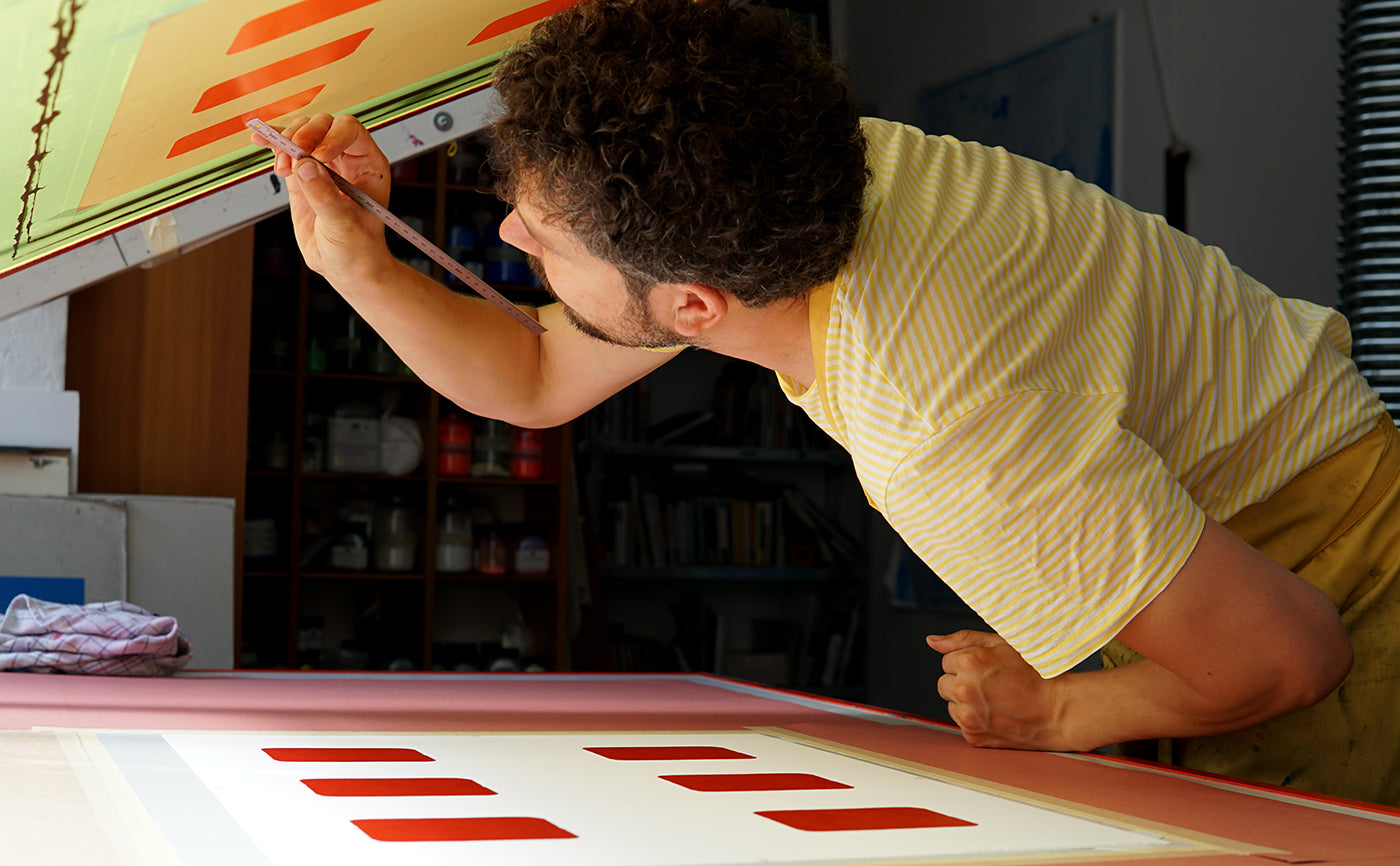
The Berlin Design Studio Reviving Hand-Print
Meet the artisan duo creating mementos for our book with Kinfolk and Norm Architects
Stefan Guzy and Björn Wiede have been operating a fine art screen printing studio in Berlin for close to two decades, something they held onto when print was deemed 'dying' in the early 2000s. Resisting mechanization, traditional hand artisan techniques are now undergoing a resurgence. We visited Handsiebdruckerei while creating mementos for our book The Touch.

Stefan Guzy and Björn Wiede have been based in their Kreuzberg studio for almost a decade, but as the landscape around them changes, they start to consider their long-term plan. (Photo: Waldemar Salesski)
Since 2010, Guzy and Wiede have had a studio space in a Paul-Lincke-Ufer courtyard. Neighbors include vinyl store Hard Wax-during our summer visit the electronic bass bouncing off the adjacent walls could be heard in the courtyard. When Tim Berners-Lee created the internet back in 1989, the print industry and physical disc format were prognosticated to wither to the online world. Instead, we are living in a backlash society where more people connect with physical objects they can trust and value artisan permanence over consumer throwaway culture.
The print mementos they created will be given to anyone who purchases a copy of The Touch at our Copenhagen launch event at Kinfolk's Gallery Space on Thursday, September 12.

Handsiebdruckerei works with their own solvent-free color system based on highly lightfast artist pigments.
How did you and Björn meet, and how did the idea of the company start?
We met at the Berlin University of the Arts studying design. As we both shared a passion for poster art and hand-printing, we soon did some work together and worked in the (nearly abandoned) screenprint workshop at school. Nobody back then in the early 2000s was interested in manual printing techniques.

Frederik Alexander Werner created the cover illustration for The Touch, his work is being used to create mementos for the launch event in Copenhagen on Thursday, September 12, 2019.
10 years into your studio, what have you learned and experienced in this time?
I started graphic design studio Zwölf quite early, in 2001, with the usual agency stuff in visual communication. When Björn Wiede became a partner in 2006 we focussed on poster and book design, did some exhibition design jobs. Now our work is split up between running the screen print studio Handsiebdruckerei Kreuzberg, still doing design jobs with Zwölf, and some teaching at art schools (right now Weimar and Halle).

For most printing applications, Handsiebdruckerei uses our professional acrylic-based screen printing ink, which they source from Italy. It is solvent-free, odorless, highly pigmented and dries silky matt.
How would you describe the nature of what Handsiebdruckerei creates and through what methods?
We try to continue the master craftsmanship of screen printers working for artists from the 1970s and 1980s before nearly all of them vanished due to digital production. We focus on custom-made ink based on artist-grade pigments (the industrial stuff is not that good) and using traditional mould-made rag paper. Therefore our clients are usually artists and bigger galleries commissioning editions and multiples.
In what ways has printing changed since you started or studied?
We were some of the earliest hand screen printing revivalist and are happy that more and more artists use manual printing techniques again. Back then in art school, everyone was into this whole new digital printing world and a lot of printing, typesetting, and bookbinding workshops were closed. Good to see that some of them came back. It's always good to do something with your hands.

Stefan balances hand-printing with his graphic design agency Zwölf and teaching on the side.
What does being part of Members of Alliance Graphique Internationale mean?
We were overwhelmed when we were inducted into AGI as the youngest German members. It's amazing to meet all these exceptional artists from all over the world. Eventually, we became friends with some and are still very impressed with the overall quality of design from all corners of the world, and the kindness of these old folks to the young ones like us.
Can you talk us through the Kinfolk invitation and what processes went into it?
The job was printed on Fabriano paper made out of cotton fibers that are too short for the textile industry-so it's not only beautiful but also quite sustainable. We used our very own custom-made ink: a Pyrrole Red mixed with an Iron Oxide Black and a hint of Bismuth Yellow. The black is our special super deep Spinel Black. Every piece was hand-printed.

Their building has housed hand-printers for close to 100 years, Stefan and Björn endeavor to continue Kreuzberg printing tradition by printing "everything that is flat except t-shirts."
What does being creative in the heart of Kreuzberg in 2019 look/feel like?
It's still an amazing part of Berlin, but the real-estate market drives you nuts. Handsiebdruckerei Marzahn could be the next thing.


